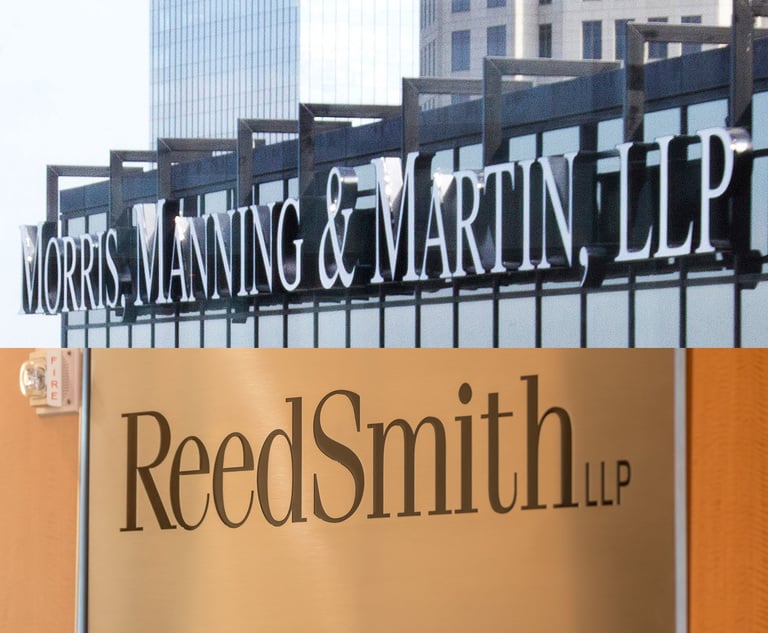Law Firm Revenues Rise as Demand Accelerates, Citi Reports
The first nine months of 2019 saw 5.1% revenue growth for a sample of 190 law firms.
November 12, 2019 at 05:30 AM
7 minute read
 Image: Shutterstock.com
Image: Shutterstock.com
There is a lot of good news in the nine-month 2019 industry results. While we might not end the year with the strong growth levels seen in 2018, we anticipate that 2019 will be a decent year. For the first time this year, revenue growth exceeded expense growth. Rate increases continued to be strong, while demand growth continued to accelerate. The collection cycle continued to lengthen, hurting revenue, but strong inventory growth places the industry in a solid position to end the year well.
These results are based on a sample of 190 firms (76 Am Law 100 firms, 54 Second Hundred firms and 60 niche/boutique firms). Thirty-one of these firms fit our definition of either international (less than 25% but more than 10% of lawyers based outside the United States) or global (at least 25% of lawyers based outside the United States). Citi Private Bank provides financial services to more than 700 U.S. and U.K. law firms and more than 50,000 individual lawyers. Each quarter, the Law Firm Group confidentially surveys firms in the Am Law 100 and the Second Hundred, along with smaller firms. In addition, we conduct a more detailed annual survey and semiannually produce the Law Firm Leaders Confidence Index. These reports, together with extensive discussions with law firm leaders, provide a comprehensive overview of current financial trends in the industry, as well as forward-looking insight.
Revenue growth of 5.1% for the first nine months of 2019 was driven largely by lawyer billing rate growth of 4.7%, as demand grew 0.9%. Each of these metrics saw accelerated growth from the first-half industry results. Indeed, demand growth accelerated from just 0.1% growth during the first six months, and this continued improvement in the demand environment mirrors what we had been hearing throughout the third quarter from our clients. The one metric that continued to hurt revenue growth was the 1.5% lengthening of the collection cycle. While this is slightly less than the 1.6% lengthening we reported during the first half, this is a continuation of a prolonged trend, and is largely driven by clients taking longer to pay bills. Looking toward what might be possible for full-year revenue growth results, inventory growth was strong at 6.7% and should continue to provide collections momentum into the fourth quarter.
Expenses were up 4.7% for the first nine months, moderating from the 5.9% growth we reported for the first half. One of the positive stories of 2019 has been the moderation of expense growth since the first quarter, as the industry absorbed the impact of the mid-2018 associate salary increases. Indeed, lawyer compensation growth moderated from 7.3% for the first half to 5.3% for the first nine months—and that is with 2% growth in lawyer head count. Operating expense growth of 4.3% was also a better result than the 4.8% growth reported for the first half. On another positive note, for the first time this year, revenue growth outpaced expense growth, removing the margin pressure seen throughout the first half of this year.
With 2% growth in total lawyer head count, and just 0.3% increase in the equity partnership, lawyer leverage was up by 2.4%. Even with an improved demand environment, we saw average lawyer productivity continue to trail 2018 results, down 0.7%. While the productivity dip has been moderating as this year has progressed, firms continue to operate in an environment where they are paying more for lower productivity.
Behind these averages, we saw some improvement from the even dispersion in demand performance we reported during the first half. That said, at 46% of firms seeing a demand decline during the first nine months of 2019, it remains a challenging environment for many firms. We also saw less volatility in demand performance, defined as alternating periods of demand growth and decline, than we saw in the first-half numbers. To measure volatility, we looked at the 146 firms reporting nine-month results in 2017, 2018 and 2019. Approximately 38% of these firms saw demand increase in the first nine months of 2018 and decrease in the first nine months of 2019, or vice versa—far lower than the 51% we reported experiencing volatility in the first-half results.
Looking at the results by revenue size, Am Law 51-100 firms continued to outperform other segments in revenue and demand growth, up 5.8% and 1.8%, respectively. While the collection cycle lengthened for these firms, Am Law 51-100 firms also had the highest inventory growth (at 7.5%), setting them up well for a strong end to the year. Am Law 1-50 firms may have trailed Am Law 51-100 firms in demand growth, but in another positive trend this year, we have seen demand performance for these firms continue to improve throughout the year, up 0.8% for the first nine months—much better than the 0.7% decline we saw during the first quarter. Am Law 1-50 rate increases continued to outpace other segments, up 5.2%, helping to drive the 5.4% growth in revenue (second only to the Am Law 51-100 firms), and in spite of the 1.6% lengthening of the collection cycle. With strong inventory levels (up 7.1%) for Am Law 1-50 firms, the outlook for the rest of the year is very positive.
The smaller firms in our sample (Am Law Second Hundred firms and Other firms) also saw improved performance in the nine-month results, though they continue to trail Am Law 100 firms in terms of revenue, rate and inventory growth. For Second Hundred firms, it is worth noting that their demand growth for the first nine months slightly outpaced Am Law 1-50 firms, at 0.9% growth.
Looking at firms by geographic reach, global firms saw the greatest growth in demand (up 2.5%) and revenue (up 6.4%). There is still some margin pressure, with expense growth of 6.5%. However, global firms also carry a 6.6% inventory increase into the fourth quarter, signaling strong collections ahead. International firms saw the greatest rate increases, at 5.9%, and positive demand momentum, reporting 0.3% growth after seeing a 0.9% decline during the first half. Revenue grew 5.1%, muted by a 2.8% lengthening of the collection cycle. The good news is that these international firms also saw an easing of the margin pressure we reported in the six-month results. They also ended the nine-month period with 8.1% inventory growth, the highest of all segments, setting them up for a strong end to 2019.
National firms saw solid revenue growth (5.6%), driven by a combination of 1.4% demand growth and 3.8% rate increases. Inventory growth of 5.9% signals a strong year-end.
Regional firms were the only segment to continue to see a demand decline, though it moderated from the 1.3% decline reported for the first half, to 0.5% decline for the nine-month period. Revenue growth of 3.5% trailed all segments, far below the 4.2% growth in expenses. Looking ahead, 6.2% growth in inventory means that there is opportunity for these firms to see a decent end to the year.
While the first nine months of 2019 saw slower revenue growth than we saw through the same period in 2018, there are several positive trends in the results. Demand growth continued to gain momentum. Rate growth has been strong. Expense pressure has moderated, easing margin pressure. Dispersion and volatility remain, but are less acute than we saw earlier in the year. Looking ahead, inventory levels are high. The biggest challenge to a strong year-end is the continued lengthening of the collection cycle. If firms are able to collect on strong inventory levels, 2019 should end well.
Gretta Rusanow is head of advisory services within Citi Private Bank's Law Firm Group.
This content has been archived. It is available through our partners, LexisNexis® and Bloomberg Law.
To view this content, please continue to their sites.
Not a Lexis Subscriber?
Subscribe Now
Not a Bloomberg Law Subscriber?
Subscribe Now
NOT FOR REPRINT
© 2025 ALM Global, LLC, All Rights Reserved. Request academic re-use from www.copyright.com. All other uses, submit a request to [email protected]. For more information visit Asset & Logo Licensing.
You Might Like
View All
Greenberg Traurig Litigation Co-Chair Returning After Three Years as US Attorney
3 minute read
Blank Rome Snags Two Labor and Employment Partners From Stevens & Lee
4 minute read
12-Partner Team 'Surprises' Atlanta Firm’s Leaders With Exit to Launch New Reed Smith Office
4 minute read
After Breakaway From FisherBroyles, Pierson Ferdinand Bills $75M in First Year
5 minute readTrending Stories
- 1'A Death Sentence for TikTok'?: Litigators and Experts Weigh Impact of Potential Ban on Creators and Data Privacy
- 2Bribery Case Against Former Lt. Gov. Brian Benjamin Is Dropped
- 3‘Extremely Disturbing’: AI Firms Face Class Action by ‘Taskers’ Exposed to Traumatic Content
- 4State Appeals Court Revives BraunHagey Lawsuit Alleging $4.2M Unlawful Wire to China
- 5Invoking Trump, AG Bonta Reminds Lawyers of Duties to Noncitizens in Plea Dealing
Who Got The Work
J. Brugh Lower of Gibbons has entered an appearance for industrial equipment supplier Devco Corporation in a pending trademark infringement lawsuit. The suit, accusing the defendant of selling knock-off Graco products, was filed Dec. 18 in New Jersey District Court by Rivkin Radler on behalf of Graco Inc. and Graco Minnesota. The case, assigned to U.S. District Judge Zahid N. Quraishi, is 3:24-cv-11294, Graco Inc. et al v. Devco Corporation.
Who Got The Work
Rebecca Maller-Stein and Kent A. Yalowitz of Arnold & Porter Kaye Scholer have entered their appearances for Hanaco Venture Capital and its executives, Lior Prosor and David Frankel, in a pending securities lawsuit. The action, filed on Dec. 24 in New York Southern District Court by Zell, Aron & Co. on behalf of Goldeneye Advisors, accuses the defendants of negligently and fraudulently managing the plaintiff's $1 million investment. The case, assigned to U.S. District Judge Vernon S. Broderick, is 1:24-cv-09918, Goldeneye Advisors, LLC v. Hanaco Venture Capital, Ltd. et al.
Who Got The Work
Attorneys from A&O Shearman has stepped in as defense counsel for Toronto-Dominion Bank and other defendants in a pending securities class action. The suit, filed Dec. 11 in New York Southern District Court by Bleichmar Fonti & Auld, accuses the defendants of concealing the bank's 'pervasive' deficiencies in regards to its compliance with the Bank Secrecy Act and the quality of its anti-money laundering controls. The case, assigned to U.S. District Judge Arun Subramanian, is 1:24-cv-09445, Gonzalez v. The Toronto-Dominion Bank et al.
Who Got The Work
Crown Castle International, a Pennsylvania company providing shared communications infrastructure, has turned to Luke D. Wolf of Gordon Rees Scully Mansukhani to fend off a pending breach-of-contract lawsuit. The court action, filed Nov. 25 in Michigan Eastern District Court by Hooper Hathaway PC on behalf of The Town Residences LLC, accuses Crown Castle of failing to transfer approximately $30,000 in utility payments from T-Mobile in breach of a roof-top lease and assignment agreement. The case, assigned to U.S. District Judge Susan K. Declercq, is 2:24-cv-13131, The Town Residences LLC v. T-Mobile US, Inc. et al.
Who Got The Work
Wilfred P. Coronato and Daniel M. Schwartz of McCarter & English have stepped in as defense counsel to Electrolux Home Products Inc. in a pending product liability lawsuit. The court action, filed Nov. 26 in New York Eastern District Court by Poulos Lopiccolo PC and Nagel Rice LLP on behalf of David Stern, alleges that the defendant's refrigerators’ drawers and shelving repeatedly break and fall apart within months after purchase. The case, assigned to U.S. District Judge Joan M. Azrack, is 2:24-cv-08204, Stern v. Electrolux Home Products, Inc.
Featured Firms
Law Offices of Gary Martin Hays & Associates, P.C.
(470) 294-1674
Law Offices of Mark E. Salomone
(857) 444-6468
Smith & Hassler
(713) 739-1250









